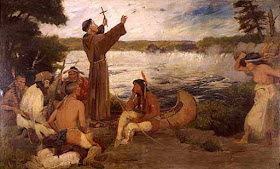But, Minnesota? What was happening there?
For me, when I think of early American history, I almost always think of Minnesota first. Why? Because I've been studying my state's history since I was a teenager, and there are a surprising number of important historical events and people who impacted not only early Minnesota history, but also a broader scope of American history.
The five biggest influences in early Minnesota history were explorers, fur traders, missionaries, warring Native American tribes, and the military presence.
 |
| Father Hennepin discovering St. Anthony Falls on the Mississippi (present-day Minneapolis), in 1680 |
 |
| French explorers and fur traders on Lake Superior. |
One notable explorer was Zebulon Pike, for whom Pike's Peak is named in Colorado. In 1805, he was sent by the United States government to find the source of the Mississippi and to locate an ideal spot for a military fort. He met with some success, as he acquired over 100,000 acres of land where Fort Snelling (near present-day St. Paul) was built in 1819. While traversing up the Mississippi, an early winter set in and he built a fort and stockade near present-day Little Falls, MN (my hometown). His men wintered there while Pike continued north. He thought he had found the source of the Mississippi, however, he was proven wrong in later years.
 |
| Zebulon Pike |
 |
| Ojibwe Chiefs in the early 1800's. |
This is just a tiny glimpse into Minnesota history and all the people and events that helped shape this beautiful and diverse state. Maybe, just maybe, Minnesota will come to mind the next time you think of early American history.
Your Turn: Are you surprised at how early Europeans discovered Minnesota? Did you realize so much was happening in this Midwest state at such an early date? Do you have any questions about Minnesota history?
 Gabrielle Meyer lives in central Minnesota on the banks of the Mississippi River with her husband and four young children. As an employee of the Minnesota Historical Society, she fell in love with the rich history of her state and enjoys writing fictional stories inspired by real people and events. Gabrielle's next release, A Mother in the Making, will be available in September from Love Inspired Historical. She can be found at www.gabriellemeyer.com where she writes about her passion for history, Minnesota, and her faith.
Gabrielle Meyer lives in central Minnesota on the banks of the Mississippi River with her husband and four young children. As an employee of the Minnesota Historical Society, she fell in love with the rich history of her state and enjoys writing fictional stories inspired by real people and events. Gabrielle's next release, A Mother in the Making, will be available in September from Love Inspired Historical. She can be found at www.gabriellemeyer.com where she writes about her passion for history, Minnesota, and her faith. Find her on Facebook
Find her on Pinterest
Find her on Twitter
Find her on Amazon
Find her on Goodreads
Find her on My Website

Gabrielle, I had no idea Minnesota played such a part in our early history. Thank you for sharing this and the pictures.
ReplyDeleteBlessings,Tina
My pleasure, Tina! I love Minnesota history, and I'm always excited to share it with anyone who will listen. :)
DeleteHey Gabrielle, Being from the Upper Peninsula of Michigan, a lot of the Minnesota history overlaps with ours! Such a rich history and I'm so glad you joined us here on Colonial Quills! Too often we are only looking at the original colonies on the East Coast and not all of what became the America we have today.
ReplyDeleteYou're right, Carrie. Minnesota does share a great deal of common history with the Upper Peninsula of Michigan, mainly because of the Great Lakes, but also because of the missionary involvement with the Ojibwe Indians and the extensive fur trading. I'm happy to be a part of Colonial Quills and to bring Minnesota into the conversation about early American history.
DeleteThank you for this posting.
ReplyDeleteI also wrote a few of my own postings in my Passion for the Past blog about early American history here in Michigan, which is very closely related to Minnesota's.
I think you might enjoy this one in particular: http://passionforthepast.blogspot.com/2015/09/life-on-18th-century-frontier-lac-ste.html
Anyhow, this was very enjoyable to read. Thank you again.
Yes, Minnesota and Michigan have very similar histories. Thank you for sharing your post link!
DeleteThanks for the small glimpse into Minnesota history. I have recently learned a little about the Kensington Runestone, dating back to around 1362, which was apparently left here by Scandinavian explorers. It is wonderful to learn more about the state I live in.
ReplyDeleteI'm very familiar with the Kensington Runestone, which was found about forty-five miles away from where I live. There is much controversy over the stone, but it's fun to think about early explorers in Minnesota. Thank you for sharing, Betti! I love hearing from a fellow Minnesotan, and I agree that it's fun to learn more about the state we live in.
Delete